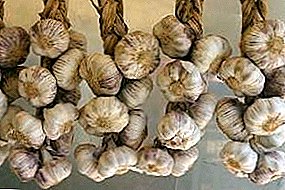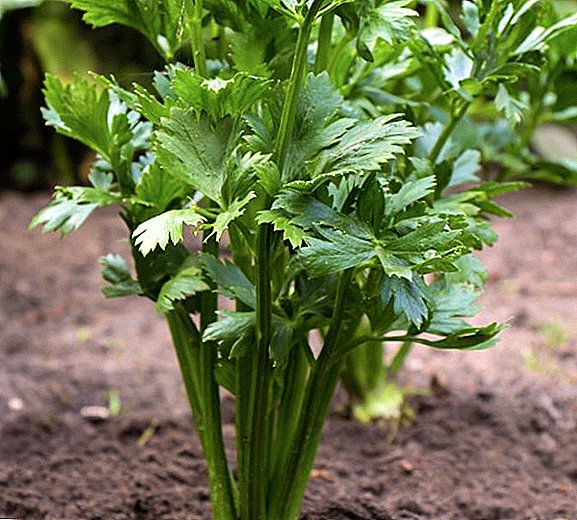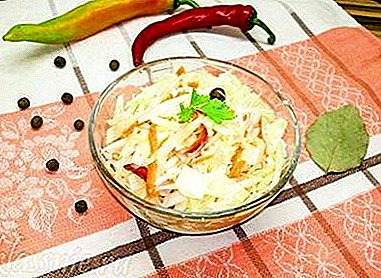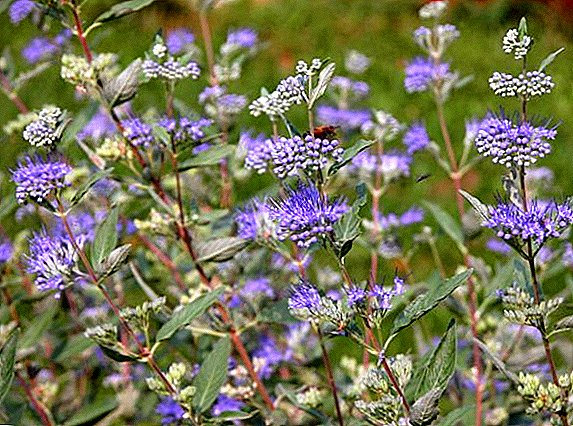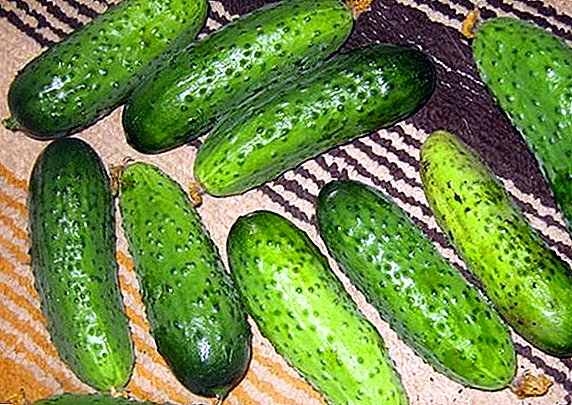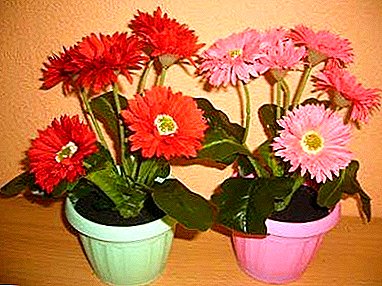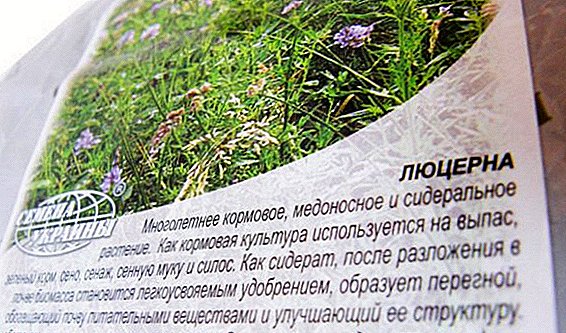 “We cannot wait for mercy from nature, to take it from her is our task” - the words of the famous biologist and breeder I.V. Michurin became a symbol of a whole epoch of consumer attitude to natural riches. The desire to take more led to the depletion of fertile lands and a glut of fertilizers of the chemical series with their fertilizers. Effective "first aid" for the elementary recovery of soil yield are sideral plants.
“We cannot wait for mercy from nature, to take it from her is our task” - the words of the famous biologist and breeder I.V. Michurin became a symbol of a whole epoch of consumer attitude to natural riches. The desire to take more led to the depletion of fertile lands and a glut of fertilizers of the chemical series with their fertilizers. Effective "first aid" for the elementary recovery of soil yield are sideral plants.
What is the value of sideratov
These green fertilizers have a variety of properties, ensuring the viability of the fertile layers. 
- The presence in the land of worms and various microorganisms indicates its "health". Siderates are food for these fertility creators.
- The well-developed root system of these plants "extracts" natural mineral elements from deep soil layers, and also supports the soil in a loose state, providing oxygen access.
- All the nutrients of the green manures necessary for the growth and fruiting of cultivated plants accumulate and retain in the upper layers of the earth, where the root system of their “wards” is located.
- Green helpers protect the soil from freezing in winter, and from excessive heating in summer, and from the destructive effects of wind and rain. The sanitary properties of green manure plants relate to the purification of the soil from some common pathogens and pests.
- Long-term growth of these amazing "living fertilizers" on completely unsuitable, exhausted, eroded lands, is able to restore their ability to fruiting.
Important! Siderats perform specific functions on different types of soils: they strengthen sandy, and clayey loosen.
- Rapidly growing green mass can be used as a mulching material and as pet food.
- Sideral plants do not allow weeds to appear on their territory.
- These green fertilizers successfully combat acidification of the soil, saturate them with nitrogen, potassium, phosphorus, calcium, sulfur. They can be used as a liquid fertilizer for watering plants.

Alfalfa as siderat: pros and cons
One of the brightest representatives of the sidereal series is alfalfa - a perennial culture of the legume family.
Did you know? In nature, more than 100 annual and perennial species of this plant are known.
In favor of growing alfalfa as a siderata says a number of its positive qualities.
- She, like all legumes, an excellent store and source of nitrogen. This process is continuous, and the roots and remnants of green mass are valuable.
- A well-developed root system, penetrating into the soil, provides a constant circulation of air and moisture.
- This herb does not require special conditions during its growth. It is cold-resistant: the temperature for its germination can reach 3-5 degrees. Regular watering does not require, as the roots provide it with moisture. So we can say that this plant is drought resistant. And after the rains, mowing volumes will exceed all expectations.
- One of the beneficial properties of alfalfa as a siderata can surely be called its ability to alkalize the soil. And in terms of its saturation with organic elements, this plant is equal to manure.
- If you grow alfalfa for more than two years, you can dramatically improve the state of exhausted, neglected land. When mowing in the first year, the land will benefit, but the full potential of green fertilizer will not be used.
Did you know? In the first year of growth, alfalfa roots grow to 1.5-2 meters. In the second year, they penetrate into the depth of 3-4 meters. And if this plant remains in one area for a longer period, then the length of the roots can reach 10 meters.
 Along with the above advantages, this culture has its drawbacks or peculiarities of its cultivation.
Along with the above advantages, this culture has its drawbacks or peculiarities of its cultivation.
- Seed material is popular and expensive, which only grows every year.
- The first month after sowing is the most difficult in the vegetative period, which is considered quite long. Requires adequate moisture, unopened. Under other conditions, alfalfa can either not climb at all, or climb areas.
- Sowing this green assistant on highly acidic or saline soils requires prior lime application. Otherwise, this plant will not give abundant greenery, and hence the effectiveness of his stay on this plot of land will be reduced to a minimum.
Plants such as oats, buckwheat, mustard, phacelia, and lupine are also used as green fertilizers.
Cultivation technology
As in any business, in the process of growing alfalfa as a green manure, there are certain requirements for this technology.
What crops to sow
To get the maximum benefit for soil fertility, you should remember that there are plants that are “allies”, but there are incompatible “antagonists”. This feature is important to consider when deciding to use green fertilizer on a certain plot of land. Lucerne is best sown after corn, potatoes, fodder winter crops, and root crops. On these soils, then cabbage, radishes, radish, tomatoes, cotton, and grain plants will give a wonderful harvest. 
When and how to plant siderat
Before you use alfalfa seeds as a siderata, you should find out when to sow them better and how to properly prepare the soil. In the autumn, the site selected for this purpose must be dug up or plowed to a depth of 25-30 cm. If it turns out that this piece of land is characterized by high acidity or saline, then it is recommended to carry out liming or making gypsum before digging.
In the spring, harrowing is carried out to level the surface of the soil and retain moisture, and then alfalfa is sown. Since some of its varieties have very small seeds, in order to evenly distribute them over the surface of the earth, it is practiced to make it along with the sand. The preliminary sowing of grain crops, harrowing, and then simple scattering of the siderata seeds is practiced.
The depth of embedment of alfalfa seeds should not exceed 2 cm. Often, after sowing, in order to compact the soil in this area, a special or home-made roller passes. Since this plant belongs to the perennial siderats and the greatest effect of it is achieved in the second and subsequent years, it is more expedient to sow it on the neglected lands.
You can sow alfalfa as a sider from spring to autumn. The main condition for good germination - the presence of moisture. It is preferable to still seeding grass in early spring. After all, after winter, the soil is fully saturated with water.
Important! For better germination, alfalfa seeds are dried in the sun and mechanically violate the integrity of the shell.
How to care
Excessive moistening of alfalfa plantings can lead to rare sprouting of the bushes. Usually enough moisture enters from the sediments and through the root system from the deep layers of the earth. It is possible to increase the amount of flowering with mineral dressings before planting a sidereal culture. Unfortunately, it is prone to powdery mildew, spotting, fusarium wilt. At the first signs of the disease should be immediately treated crops Bordeaux liquid. 
When to mow
The first time green fertilizer blooms 50-60 days after sowing. It is during this period that it must be mowed and left for rotting, or collected on compost, or used for livestock feed. Alfalfa afterblown will bloom in 30-40 days. In no case should we prevent the stalks of this sidereal culture from hardening, because it will be difficult to introduce hard stems into the soil as an organic fertilizer. The timing of its transformation will be delayed and will not bring the desired effect in the desired period.
Adherence to the technology of sowing material selection, soil preparation, crop rotation, proper care and timely grass mowing will contribute to the active growth of alfalfa, and therefore enrich the soil with nutrients, increase its fertility.


